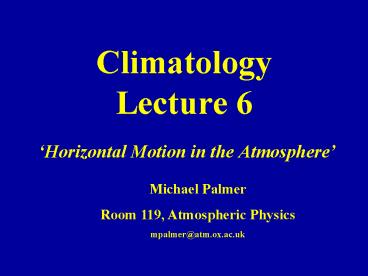Climatology Lecture 6 - PowerPoint PPT Presentation
1 / 31
Title:
Climatology Lecture 6
Description:
Geostrophic Wind. Balance between PGF and Coriolis Force. above the surface (above 1km) ... Geostrophic wind. Gradient wind. Friction and the Ekman spiral ... – PowerPoint PPT presentation
Number of Views:124
Avg rating:3.0/5.0
Title: Climatology Lecture 6
1
ClimatologyLecture 6
- Horizontal Motion in the Atmosphere
Michael Palmer Room 119, Atmospheric
Physics mpalmer_at_atm.ox.ac.uk
2
Course Outline
- Heat and the Earths Atmosphere
- Vertical Motion Stability
- Horizontal Motion Winds
- The General Circulation Midlatitudes
- The General Circulation Tropics
- Variability of the General Circulation
3
WIND
Why do we have wind??!Which direction does it
go in?What governs how strong it is??!
4
Wind
- Pressure gradient force
- Coriolis Force
- Geostrophic wind
- Gradient wind
- Friction and the Ekman spiral
5
Pressure Gradient Force
LOW pressure
Height (meters)
Pressure (hPA)
HIGH pressure
surface
6
Pressure Gradient Force
LOW
HIGH
7
Pressure Gradient Force
- Wind is driven by differences in pressure
- Differences in pressure arise both vertically and
horizontally - Vertical differences are balanced by gravity
(hydrostatic equilibrium) - Differences in pressure arise on a large scale
- PGF is directed from areas of high pressure to
low pressure - It is perpendicular to isobars (lines of equal
pressure) and the closer the isobar spacing, the
greater the PGF.
PGF
? density change of pressure over
distance
8
(No Transcript)
9
(No Transcript)
10
(No Transcript)
11
Wind
- Pressure gradient force
- Coriolis Force
- Geostrophic wind
- Gradient wind
- Friction and the Ekman spiral
12
Coriolis Force
- deflection force
- depends on latitude, wind speed, earths
rotation rate - 2.w.V.sinØ
- sine of latitude Ø equator zero poles 1
- acts to the left in SH and to the right in NH
- acts at right angles to the wind
- deflection is proportion to wind speed
13
A
r
O
Consider a toy car, initially at rest on a large
disc, then pushed so that it travels from O to A
at constant velocity V. It will move through
distance r in time t r V.t (distance
velocity x time) No problem..But what if the
disc is rotating??!
14
w
w rotation rate (degrees per sec or radians
per sec.. 1 radian 180/p deg)
A
r
B
?
O
r V.t (distance velocity x time) In the
time (t) it takes for the car to go from O to A,
A has moved round to B. The disc has rotated
through angle OAB or ? ? w.t (angle turned
through angular velocity x time)
15
w
w rotation rate (degrees per sec or radians
per sec.. 1 radian 180/p deg)
A
r
B
?
O
r V.t (distance velocity x time) In the
time (t) it takes for the car to go from O to A,
A has moved round to B. The disc has rotated
through angle OAB or ? ? w.t (angle turned
through angular velocity x time)
16
w
A
w rotation rate (degrees per sec or radians per
sec.. 1 radian 180/pi deg)
r
B
?
O
r V.t (distance velocity x time) ? w.t
(angle turned through angular velocity x time)
The distance AB is given by AB r ?
V.t.w.t The distance from A to B may also be
written AB a.t2/2 So a.t2/2 V.t.w.t
a 2.w.V.
Coriolis acceleration,
17
But, unfortunately, we know that the world is not
a flat disc! So a little adjustment is needed.
pole
sin Ø 1
w
wsinØ
Ø
sin Ø 0
equator
18
But, unfortunately, we know that the world is not
a flat disc! So a little adjustment is needed.
pole
sin Ø 1
w
Rotating disc a 2.w.V. Rotating earth a
2.w.V.sin Ø
wsinØ
Ø
sin Ø 0
equator
19
Wind
- Pressure gradient force
- Coriolis Force
- Geostrophic wind
- Gradient wind
- Friction and the Ekman spiral
20
Geostrophic Wind
- Balance between PGF and Coriolis Force
- above the surface (above 1km) in extratropics
- wind blows parallel to isobars
21
Geostrophic Wind
PGF Coriolis Force
22
(No Transcript)
23
(No Transcript)
24
Wind
- Pressure gradient force
- Coriolis Force
- Geostrophic wind
- Gradient wind
- Friction and the Ekman spiral
25
(No Transcript)
26
(No Transcript)
27
Wind
- Pressure gradient force
- Coriolis Force
- Geostrophic wind
- Gradient wind
- Friction and the Ekman spiral
28
(No Transcript)
29
(No Transcript)
30
(No Transcript)
31
Readings for todays lecture
- Barry and Chorley 1997 p76-86
- Briggs et al. 1997 Fundamentals of the Physical
Environment p78-88 - Henderson-Sellers and Robinson 1999 p56-74
- Linacre and Geerts 1997 Climates and Weather
Explained p127-145 - McIlveen 1992 chp 7. Esp p186-190































